Difference between revisions of "Conditional Import for Version 6.0 (Portal)"
| Line 1: | Line 1: | ||
| − | = | + | =Conditional Import for Version 6.0 (P60-7_18_1-09242016)= |
| − | == | + | ==Overview== |
| − | + | Versions of OnePager Pro and Express '''prior''' to 6.0 required you to insert a column (i.e., flag columns) into your plan source file that tells OnePager which rows to import. These flag columns for Microsoft Project plan source files were typically columns named '''Flag1 through Flag20'''. OnePager Pro ('''OPP''') used these flag columns to control the import of rows. In both OnePager Pro and Express ('''OPX''') you could use '''Numeric''' columns or '''Boolean''' columns as long as the contents were '''1’s''' to indicate '''Yes '''(bring in this row) or '''0’s''' to indicate '''No''' (do not import this row). | |
| − | + | This approach to controlling the import of Microsoft Project/Excel plan source file rows is quite flexible. However, it required a modification to the plan source file before import to OnePager so you can limit the rows presented in the resulting project view. | |
| − | + | The articles in this '''Conditional Import '''series will explain how you can use '''Conditional Import''' to simplify the '''import''' of data into OnePager and increase your flexibility when preparing project views to support project schedule conversations and presentations. | |
| − | + | ===Upfront Links to Conditional Import Detailed Articles=== | |
| − | + | For those of you who would like to get started right away in mastering '''Conditional Import''' at a more detailed level, the links immediately below will take you to the information. If you first would like to see some examples of how '''Conditional Import''' can be used, please read the material beyond the links below: | |
| − | = | + | {| class="wikitable" |
| − | + | | [[Conditional Import for OnePager Pro Add-in for Version 6.0 | Conditional Import for OnePager Pro Add-in]] | |
| + | |- | ||
| + | | [[Conditional Import for OnePager Pro Desktop for Version 6.0 | Conditional Import for OnePager Pro Desktop]] | ||
| + | |- | ||
| + | | [[Conditional Import for OnePager Express Add-in for Version 6.0 | Conditional Import for OnePager Express Add-in]] | ||
| + | |- | ||
| + | |[[Conditional Import for OnePager Express Desktop for Version 6.0 | Conditional Import for OnePager Express Desktop]] | ||
| + | |] | ||
| − | + | To get you started, we want to offer several examples of how '''Conditional Import''' may be used. As you gain experience with the feature, no doubt, you will find many more ways to take advantage of its flexibility. | |
| − | + | ==Examples== | |
| − | + | In '''OPP''' and '''OPX''' version 6.0, the capability for you to control the '''import''' of rows from your plan source files is made even more flexible with the addition of new '''Conditional Import''' capability. In this section there are three situations you may have encountered in the past with OnePager that can be facilitated better with '''Conditional Import''': | |
| − | + | ||
| − | + | ||
| − | + | ||
| − | + | ||
| − | + | ||
| − | + | ||
| − | + | ||
| − | + | ||
| − | + | ||
| − | + | ||
| − | + | ||
| − | + | ||
| − | + | ||
| − | + | ||
| − | + | ||
| − | + | ||
| − | + | ||
| − | + | ||
| − | + | ||
| − | + | ||
| − | + | ||
| − | + | ||
| − | + | ||
| − | + | ||
| − | + | ||
| − | + | ||
| − | + | ||
| − | + | ||
| − | + | ||
| − | + | ||
| − | + | ||
| − | + | ||
| − | + | ||
| − | + | ||
| − | + | ||
| − | + | ||
| − | = | + | ===When a Flag Field Isn’t Sufficient=== |
| − | = | + | |
| − | + | ||
| − | + | ||
| − | + | ||
| − | + | ||
| − | + | ||
| − | + | ||
| − | + | ||
| − | + | ||
| − | + | ||
| − | + | ||
| − | + | ||
| − | + | ||
| − | + | ||
| − | + | ||
| − | + | ||
| − | + | ||
| − | + | ||
| − | + | ||
| − | + | ||
| − | + | ||
| − | + | ||
| − | + | ||
| − | + | ||
| − | + | ||
| − | + | ||
| − | + | ||
| − | + | ||
| − | + | ||
| − | + | ||
| − | + | ||
| − | + | ||
| − | + | ||
| − | + | ||
| − | + | ||
| − | + | ||
| − | + | ||
| − | + | ||
| − | + | ||
| − | + | 1) There are occasions where you would like to '''import '''a plan source file row but only when the contents of a specified column holds a desired value or range of values. In this case, using a flag field may not be flexible enough or may be too time consuming to use. | |
| − | + | ||
| − | + | ||
| − | + | 2) Suppose you might want to include plan source file rows where task/milestone '''Start''' dates are greater than a specified date. Prior to '''OPP/OPX''' version 6.0 you would have to manually locate and modify the '''flag''' cell contents for those rows meeting the desired condition before importing. With version 6.0 you can clearly specify, in a '''Conditional Import''' rule, defined before the import process begins, the conditions that meets any logical combination of criteria '''WITHOUT''' making modifications to the plan source file. Here’s how it might work: | |
| − | + | ||
| − | + | :a) We’ll use the BlueGrass Project 2J-303 Microsoft Project plan source file as an example. Recall that the column headers look something like this: | |
| − | + | ||
| − | + | <center>[[File:P60-7_18_1-60-(1)-09242016.png]]</center> | |
| − | + | ||
| − | + | <center>P60-7_18_1-60-(1)-09242016.png</center> | |
| − | + | ||
| − | + | :b) For this example you only want to import tasks/milestones that have a '''Start''' date greater than 10/11/2015 but less than 12/31/2015. You can do that by first launching Microsoft Project with the plan source file loaded as shown above. Next, launch '''OPP''' version 6.0 from the Microsoft Project tool bar as you normally do and click the '''NEW''' button option. When this is done the following '''OnePager Choices '''form appears: | |
| − | + | ||
| − | + | <center>[[File:P60-7_18_1-60-(2)-09242016.png]]</center> | |
| − | == | + | |
| − | + | <center>P60-7_18_1-60-(2)-09242016.png</center> | |
| − | + | ||
| − | + | :c) The '''OnePager choices''' ('''OPC''') form above has an additional radio button in the '''Task Selection''' section, '''Select tasks by custom filter''' and a new button called '''Edit filter…'''. Before clicking the '''Select tasks by customer filter''' button, update the project view name and snapshot date such that the '''OPC''' form looks like this: | |
| − | + | ||
| − | + | <center>[[File:P60-7_18_1-60-(3)-09242016.png]]</center> | |
| − | + | ||
| − | + | <center>P60-7_18_1-60-(3)-09242016.png</center> | |
| − | + | ||
| − | = | + | :d) Now, click the '''Select tasks by custom filter''' button. When you do, a blank '''Custom Import Rules''' form will appear as show below: |
| − | ==== | + | |
| − | + | <center>[[File:P60-7_18_1-60-(4)-09242016.png]]</center> | |
| − | + | ||
| − | ==== | + | <center>P60-7_18_1-60-(4)-09242016.png</center> |
| − | + | ||
| − | + | :e) You can now compose the two rules needed to import rows that have '''Start''' dates greater than 10/11/2015 but less than 12/31/2015. When you do this, the '''Conditional Import Rules''' form will look like this: | |
| − | + | ||
| − | + | <center>[[File:P60-7_18_1-60-(5)-09242016.png]]</center> | |
| − | + | ||
| − | ==== | + | <center>P60-7_18_1-60-(5)-09242016.png</center> |
| − | + | ||
| − | + | :f) Note that the '''All of the following rules are true''' radio button is selected so that the two rules are essentially an '''AND''' operation. When you click '''OK '''on the form, it will disappear and you will be back at the '''OPC '''form once more. At this point. click the '''Create new project view''' button and '''OPP''' will create the project view that looks like this: | |
| − | + | ||
| − | + | <center>[[File:P60-7_18_1-60-(6)-09242016.png]]</center> | |
| − | (7.18 | + | |
| + | <center>P60-7_18_1-60-(6)-09242016.png</center> | ||
| + | |||
| + | |||
| + | :g) In the project view above, there are tasks that extend beyond 12/31/2015 but there are no tasks that '''Start''' on or after 12/31/2015. Similarly, there are no tasks that '''Start '''before 10/11/2015. | ||
| + | |||
| + | :h) When the project view is saved, the '''Conditional Import''' rules are saved as well and will be used to control the '''import''' for subsequent snapshots. Further, in either this snapshot or subsequent ones, the '''Conditional Import''' rules can be edited (i.e., changed, added, or deleted). When such changes are made to the '''Conditional '''Import rules, the current '''new snapshot''' or the '''snapshot '''being '''replaced '''will be configured by the active set of '''Conditional Import '''rules. Finally, you can always revert to using '''flag''' columns or select '''All''' tasks for import. | ||
| + | |||
| + | :i) An important thing to remember is that the '''Conditional Import''' rules, like the use of a single '''flag''' column, applies to '''only the current snapshot'''. Therefore, changing the '''Conditional Import''' rules for a down timeline '''snapshot''' will '''NOT '''change the look for all previous snapshots unless further '''Conditional Import '''rules changes are specifically made for these '''snapshots '''via the '''REPLACE snapshot''' procedure. | ||
| + | |||
| + | 3) '''Conditional Import''' is a powerful new capability that allows you to better control the content of your project views. '''Conditional Import''' also makes project views more useful in '''project schedule analysis''' presentations/discussions that usually accompany project management. As such, OnePager becomes not only a '''presentation''' tool but an addition to your suite of project schedule '''analysis''' tools. | ||
| + | |||
| + | ===When Microsoft Project/Excel Plan Source Files are Read-Only=== | ||
| + | |||
| + | 4) Occasions may also arise where you are not able to modify a Microsoft Project or Excel plan source file. For instance, with a read-only file you might be unable to add the required '''import''' control '''flag''' columns or be unable to change them. You would have to first import them all and manually edit out or hide the unwanted row tasks/milestones after the project view is created. Again, version 6.0 allows you to specify '''import conditions''' that meet your needs, say, only the rows which correspond to a particular project '''Phase''' for which there are data already available in the plan’s source file. The example below will illustrate this: | ||
| + | |||
| + | :a) Consider the Microsoft Project plan source file just below which has no '''flag''' field columns defined and happens to be Read-only: | ||
| + | |||
| + | <center>[[File:P60-7_18_1-60-(7)-09242016.png]]</center> | ||
| + | |||
| + | <center>P60-7_18_1-60-(7)-09242016.png</center> | ||
| + | |||
| + | :b) For the sake of this example, we will assume that '''Flag1''' through '''Flag20''' are not defined and have no data in the rows even if these columns are hidden in Microsoft Project. You need, again for illustration, something to control the '''import''' of rows. We’ll use the '''Phase''' column which happens to be the Microsoft Project '''Text30''' column. | ||
| + | |||
| + | :c) Following the same sequences as in the previous example, we’ll launch '''OPP''' from the Microsoft Project tool bar, select the '''NEW''' option from the '''OnePager Start ''' form, and make project view name and snapshot date modifications to the '''OPC '''form as shown below: | ||
| + | |||
| + | <center>[[File:P60-7_18_1-60-(8)-09242016.png]]</center> | ||
| + | |||
| + | <center>P60-7_18_1-60-(8)-09242016.png</center> | ||
| + | |||
| + | :d) In the Microsoft Project plan source file there are a total of six (6) possible '''Phase''' names. In this example, we’ll use '''Conditional Import''' to just build a project view showing '''Phase II''' task and milestones by creating a '''Conditional Import '''rule that looks like this: | ||
| + | |||
| + | <center>[[File:P60-7_18_1-60-(9)-09242016.png]]</center> | ||
| + | |||
| + | <center>P60-7_18_1-60-(9)-09242016.png</center> | ||
| + | |||
| + | :e) This simple '''Conditional Import''' rule gives you access to all the tasks associated with '''Phase II'''. So now click the '''OK '''button on the above form and then click the '''Create project view''' button on the '''OPC''' form to create the project view as shown below: | ||
| + | |||
| + | <center>[[File:P60-7_18_1-60-(10)-09242016.png]]</center> | ||
| + | |||
| + | <center>P60-7_18_1-60-(10)-09242016.png</center> | ||
| + | |||
| + | 5) Since '''OPP''' was told to generate the legend using the '''Resource Names''' column from the Microsoft Project plan source file, you see that only one phase name is displayed. '''Team 2''' is shown in the legend as the only resource name participating in '''Phase II''' of the project. Using '''Conditional Import''' first overcomes any difficulty dealing with a Read-only file and, second, allows you to '''focus''' on the second phase of the project to see the details in the plan. In this case the resources assigned. Again, '''Conditional Import''' becomes an '''analysis''' aid as well as a '''presentation''' aid. | ||
| + | |||
| + | ===Analysis Using an Existing Project View=== | ||
| + | |||
| + | 6) There are also occasions where you may want to go back '''AFTER''' a project view is created and '''update''' the project view to look at rows controlled by another '''flag '''column. You may also want to build project views to do some '''analysis''' on the project schedule. This is easily done '''AFTER''' the project view was created by looking at other logical relationship within the Microsoft Project/Excel plan source file data. | ||
| + | |||
| + | ====Changing the Flag Field AFTER the Project View is Created==== | ||
| + | |||
| + | 7) Making changes to the '''flag '''field column case after a project view is created is quite easy using the controls from the OnePager '''Project View Editor’s '''Data''' '''tab. | ||
| + | |||
| + | :a) First, launch Microsoft Project with the original plan source file and click the '''OnePager''' button on the Microsoft Project tool bar. Then, click the '''UPDATE''' button on the '''OnePager Start''' form. This will load the project view into the '''OPP’s''' '''Project View Editor '''('''PVE''')'''. ''' | ||
| + | |||
| + | :b) With the '''PVE''' running, go to the '''Data tab''' and click the '''Custom Update''' button which brings up the '''OPC''' form shown in the illustration below. | ||
| + | |||
| + | :c) In this form, make sure the '''Select tasks with ‘Yes’ in column''' button is on, click the dropdown menu, and select the alternate '''flag''' field column as shown below: | ||
| + | |||
| + | <center>[[File:P60-7_18_1-60-(11)-09242016.png]]</center> | ||
| + | |||
| + | <center>P60-7_18_1-60-(11)-09242016.png</center> | ||
| + | |||
| + | :d) In the above project view, which was created originally using '''Custom Import''' rules, you are changing the '''import''' control back to a defined '''flag '''column, specifically, '''Flag10'''. When you do this and '''REPLACE''' the snapshot you get the following updated project view: | ||
| + | |||
| + | <center>'''Doing the above described action doesn’t presently work either from OPEN or UPDATE (12)'''</center> | ||
| + | |||
| + | :e) This example illustrates how you can revert from using '''Conditional Import''' rules to the more conventional use of '''flag''' columns to control '''import'''. | ||
| + | |||
| + | ====Changing Custom Import Rules AFTER the Project View is Created==== | ||
| + | |||
| + | 8) As was mentioned earlier, before version 6.0, handling '''import '''condition change situations meant totally starting over by going back to the '''OnePager Start''' form and selecting a different '''flag''' column. Version 6.0 lets you change the '''import conditions''' from the '''PVE''' by using the '''Data tab’s Custom Update''' button to access your '''Conditional Import''' rules and edit them. Here’s how changing '''Conditional Import''' rules can be done '''AFTER''' the project view is created: | ||
| + | |||
| + | :a) Consider the previous example where you wanted to create a project view consisting of tasks/milestones with '''Start''' dates later than 10/11/2015 and earlier than 12/31/2015. Suppose you have that project view in the '''PVE''' and you want to '''import''' additional tasks/milestones for display that have '''Finish''' dates less than 4/1/2016. | ||
| + | |||
| + | :b) You can do this by first bringing up the project view from Microsoft Project by launching OnePager and clicking the '''UPDATE''' button in the '''OnePager Start''' form. This brings up the '''PVE''' displaying the project view with the two '''Start''' date '''Conditional Import Rules''' defined previously. | ||
| + | |||
| + | :c) Next, go to the '''Data tab''', click the '''Custom Update''' button bringing up the '''OPC''' form created in a previous example. | ||
| + | |||
| + | :d) Then, click the '''Edit Filters…''' button to bring up the '''Conditional Import Rules''' form which displays the two rules. You can now modify the '''Conditional Import''' rules by '''Adding''' a new rule as shown below: | ||
| + | |||
| + | <center>[[File:P60-7_18_1-60-(13)-09242016.png]]</center> | ||
| + | |||
| + | <center>P60-7_18_1-60-(13)-09242016.png</center> | ||
| + | |||
| + | |||
| + | <center>'''The Add Rule button didn’t work. Used the Copy Button to copy the second rule then edited it to make above screenshot. '''</center> | ||
| + | |||
| + | :e) Now, click '''OK''' on the '''Conditional Import Rules''' form to return to the '''OPC''' form where you should click the '''REPLACE existing snapshot with date''' button and use the dropdown calendar to select a '''replacement snapshot date''' as shown below: | ||
| + | |||
| + | <center>[[File:P60-7_18_1-60-(14)-09242016.png]]</center> | ||
| + | |||
| + | <center>P60-7_18_1-60-(14)-09242016.png</center> | ||
| + | |||
| + | :f) Then, click the '''Replace dates''' button on the '''OPC '''form and the following project view will appear: | ||
| + | |||
| + | <center>[[File:P60-7_18_1-60-(16)-09242016.png]]</center> | ||
| + | |||
| + | <center>P60-7_18_1-60-(16)-09242016.png</center> | ||
| + | |||
| + | <center>'''Using the three rules shown CI Rule form above gives what I think is an erroneous result above. I conclude that using the Copy Rule and editing that rule does not produce the desired results. A previous attempt using the Copy Rule and editing that rule to be Finish>4/1/2016 gave a two row project view. The project view should have all the tasks shown in P60-7_18_1-60-(6)-09242016.png plus additional task/milestones that have Finish dates less 4/1/2016. The only difference between this 3 rule project view and the previous 2 rule project view is show in the red rectangle above.'''</center> | ||
| + | |||
| + | <center>'''It may be that the combination of rules and the actual date in the .mpp file has conspired to give this result. I will investigate.'''</center> | ||
| + | |||
| + | ==Organization of Articles In the Conditional Import Section== | ||
| + | |||
| + | There are four detailed articles in this section available at the links below corresponding to each of the desktop products offered by Chronicle Graphics, Inc: '''OnePager Pro Add-in, OnePager Pro Desktop, OnePager Express Add-in, and OnePager Express Desktop'''. | ||
| + | |||
| + | Within each article, there is an Overview sub-section and the articles are further sub-sectioned by the three options that are available to you from the '''OnePager choices''' form: '''NEW, UPDATE, and OPEN'''. | ||
| + | |||
| + | {| class="wikitable" | ||
| + | | [[Conditional Import for OnePager Pro Add-in for Version 6.0 | Conditional Import for OnePager Pro Add-in]] | ||
| + | |- | ||
| + | | [[Conditional Import for OnePager Pro Desktop for Version 6.0 | Conditional Import for OnePager Pro Desktop]] | ||
| + | |- | ||
| + | | [[Conditional Import for OnePager Express Add-in for Version 6.0 | Conditional Import for OnePager Express Add-in]] | ||
| + | |- | ||
| + | |[[Conditional Import for OnePager Express Desktop for Version 6.0 | Conditional Import for OnePager Express Desktop]] | ||
| + | |} | ||
| + | |||
| + | ==Related Links:== | ||
| + | |||
| + | [[Basic Workflows for Version 6.0 (Portal) | Basic Workflows (Portal)]] | ||
| + | |||
| + | [[Conditional Formatting for Version 5.3 (Portal) | Conditional Formatting (Portal)]] | ||
| + | |||
| + | [[Using the OnePager "Data" Tab's "Selected file(s)" Button for Version 6.0 | Using the OnePager "Data" Tab's "Selected file(s)" Button]] | ||
| + | |||
| + | [[OnePager Express Import of Data from Microsoft Excel]] | ||
| + | |||
| + | [[Message to Assist with Setting Import Flags When No Data Are Imported]] | ||
| + | |||
| + | [[Understanding Project Views and Snapshots for OnePager Pro]] | ||
| + | |||
| + | [[Understanding Project Views and Snapshots for OnePager Express]] | ||
| + | |||
| + | (7.18.1-60) | ||
| − | + | [[Category:Version 6.0]] | |
| − | + | [[Category:Add-in]] | |
| − | + | [[Category:Desktop]] | |
| − | + | [[Category:Basic Workflows]] | |
| − | + | [[Category:Conditional Import]] | |
| − | + | [[Category:Importing]] | |
| − | + | [[Category:Project Views]] | |
| − | + | [[Category:Editing the Project View]] | |
| − | + | [[Category:OnePager - Tool Bar]] | |
| − | + | [[Category:Basic Workflows]] | |
| − | + | [[Category:Snapshots]] | |
| − | + | [[Category:Task/Milestone Editing]] | |
| − | + | [[Category:Conditional Formatting]] | |
| − | + | [[Category:Getting Started with Version 6.0]] | |
| − | + | [[Category:OnePager Pro]] | |
| − | + | [[Category:OnePager Express]] | |
| − | + | ||
| − | + | ||
| − | + | ||
| − | + | ||
| − | + | ||
| − | + | ||
| − | + | ||
| − | + | ||
| − | + | ||
| − | + | ||
| − | + | ||
| − | + | ||
| − | + | ||
| − | + | ||
| − | + | ||
| − | + | ||
| − | + | ||
| − | + | ||
| − | + | ||
| − | + | ||
| − | + | ||
| − | + | ||
| − | + | ||
Revision as of 17:38, 30 September 2016
Contents
Conditional Import for Version 6.0 (P60-7_18_1-09242016)
Overview
Versions of OnePager Pro and Express prior to 6.0 required you to insert a column (i.e., flag columns) into your plan source file that tells OnePager which rows to import. These flag columns for Microsoft Project plan source files were typically columns named Flag1 through Flag20. OnePager Pro (OPP) used these flag columns to control the import of rows. In both OnePager Pro and Express (OPX) you could use Numeric columns or Boolean columns as long as the contents were 1’s to indicate Yes (bring in this row) or 0’s to indicate No (do not import this row).
This approach to controlling the import of Microsoft Project/Excel plan source file rows is quite flexible. However, it required a modification to the plan source file before import to OnePager so you can limit the rows presented in the resulting project view.
The articles in this Conditional Import series will explain how you can use Conditional Import to simplify the import of data into OnePager and increase your flexibility when preparing project views to support project schedule conversations and presentations.
Upfront Links to Conditional Import Detailed Articles
For those of you who would like to get started right away in mastering Conditional Import at a more detailed level, the links immediately below will take you to the information. If you first would like to see some examples of how Conditional Import can be used, please read the material beyond the links below:
| Conditional Import for OnePager Pro Add-in | |||||
| Conditional Import for OnePager Pro Desktop | |||||
| Conditional Import for OnePager Express Add-in | |||||
| Conditional Import for OnePager Express Desktop | ]
To get you started, we want to offer several examples of how Conditional Import may be used. As you gain experience with the feature, no doubt, you will find many more ways to take advantage of its flexibility. ExamplesIn OPP and OPX version 6.0, the capability for you to control the import of rows from your plan source files is made even more flexible with the addition of new Conditional Import capability. In this section there are three situations you may have encountered in the past with OnePager that can be facilitated better with Conditional Import: When a Flag Field Isn’t Sufficient1) There are occasions where you would like to import a plan source file row but only when the contents of a specified column holds a desired value or range of values. In this case, using a flag field may not be flexible enough or may be too time consuming to use.

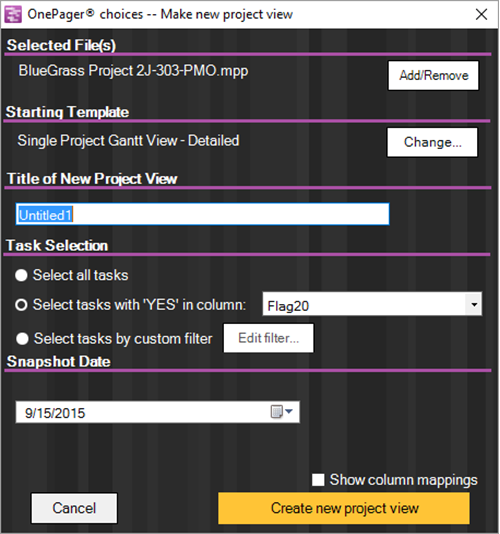
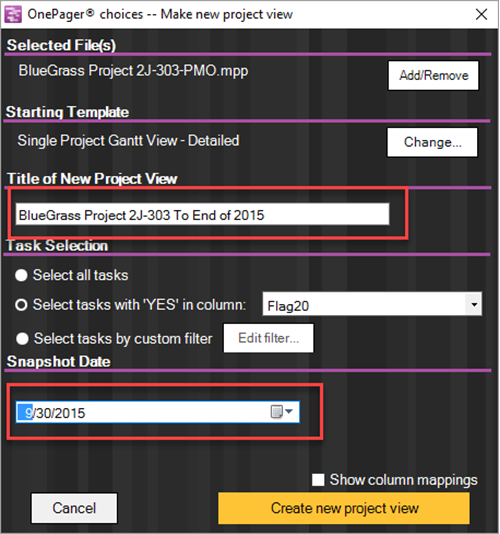
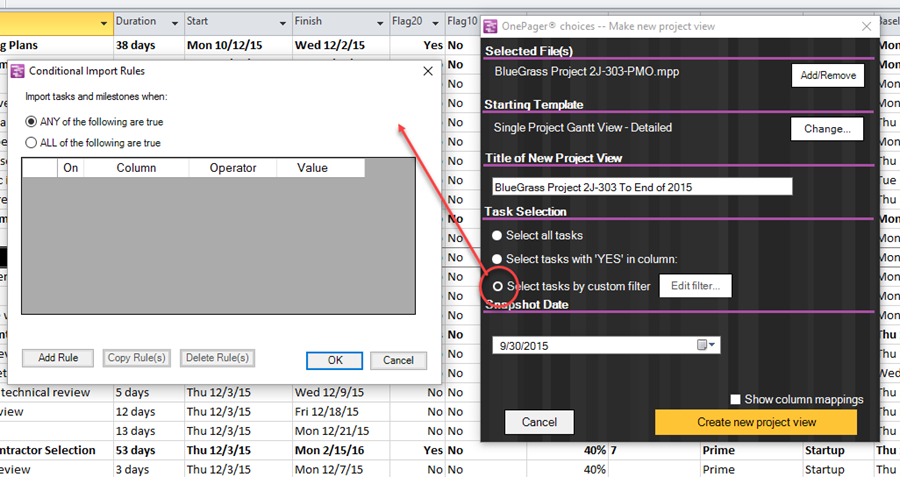
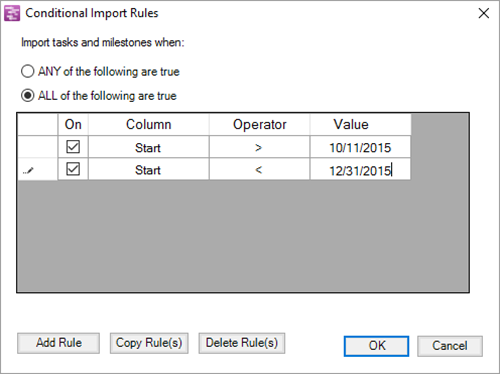
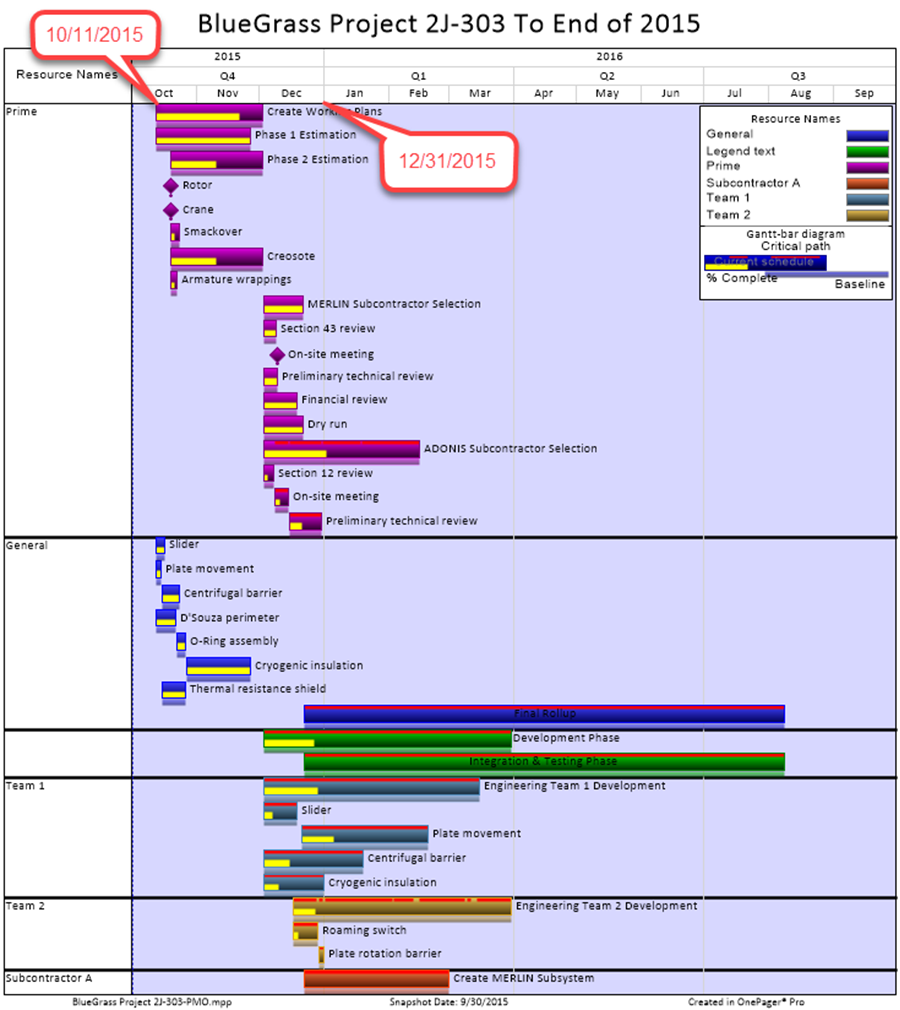
3) Conditional Import is a powerful new capability that allows you to better control the content of your project views. Conditional Import also makes project views more useful in project schedule analysis presentations/discussions that usually accompany project management. As such, OnePager becomes not only a presentation tool but an addition to your suite of project schedule analysis tools. When Microsoft Project/Excel Plan Source Files are Read-Only4) Occasions may also arise where you are not able to modify a Microsoft Project or Excel plan source file. For instance, with a read-only file you might be unable to add the required import control flag columns or be unable to change them. You would have to first import them all and manually edit out or hide the unwanted row tasks/milestones after the project view is created. Again, version 6.0 allows you to specify import conditions that meet your needs, say, only the rows which correspond to a particular project Phase for which there are data already available in the plan’s source file. The example below will illustrate this:

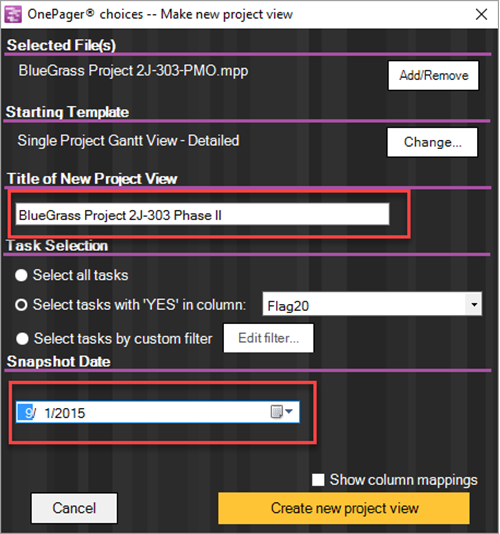
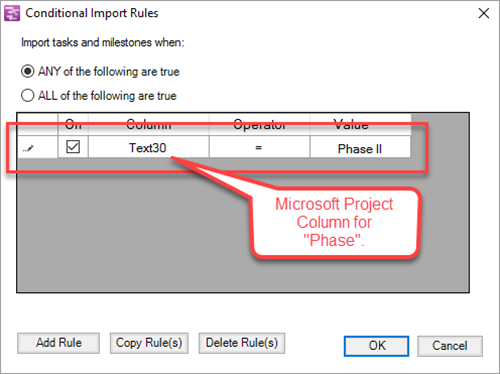
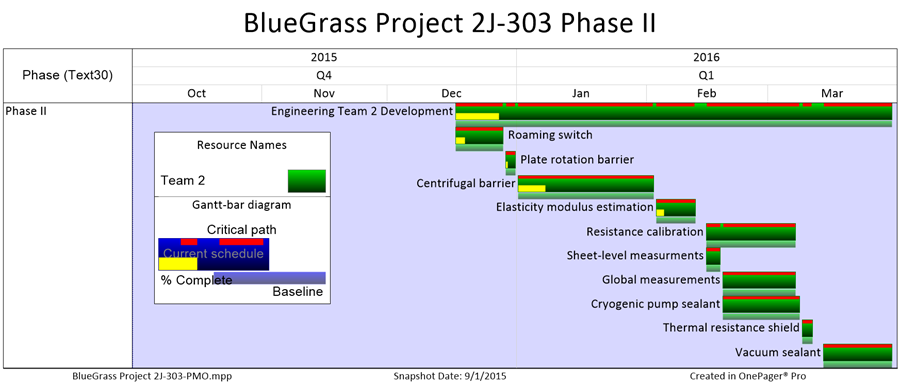 5) Since OPP was told to generate the legend using the Resource Names column from the Microsoft Project plan source file, you see that only one phase name is displayed. Team 2 is shown in the legend as the only resource name participating in Phase II of the project. Using Conditional Import first overcomes any difficulty dealing with a Read-only file and, second, allows you to focus on the second phase of the project to see the details in the plan. In this case the resources assigned. Again, Conditional Import becomes an analysis aid as well as a presentation aid. Analysis Using an Existing Project View6) There are also occasions where you may want to go back AFTER a project view is created and update the project view to look at rows controlled by another flag column. You may also want to build project views to do some analysis on the project schedule. This is easily done AFTER the project view was created by looking at other logical relationship within the Microsoft Project/Excel plan source file data. Changing the Flag Field AFTER the Project View is Created7) Making changes to the flag field column case after a project view is created is quite easy using the controls from the OnePager Project View Editor’s Data tab.
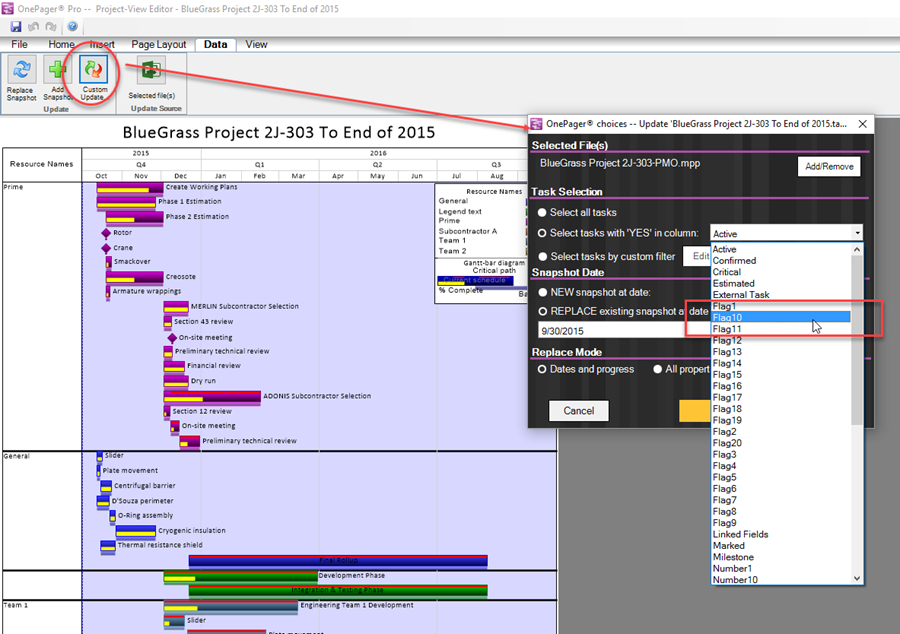
Changing Custom Import Rules AFTER the Project View is Created8) As was mentioned earlier, before version 6.0, handling import condition change situations meant totally starting over by going back to the OnePager Start form and selecting a different flag column. Version 6.0 lets you change the import conditions from the PVE by using the Data tab’s Custom Update button to access your Conditional Import rules and edit them. Here’s how changing Conditional Import rules can be done AFTER the project view is created:
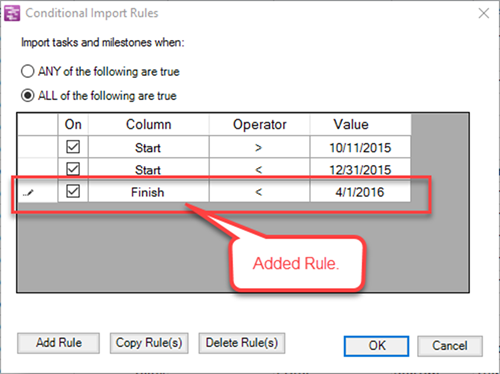
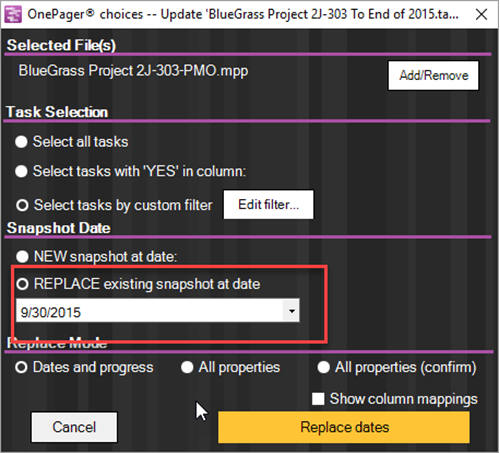
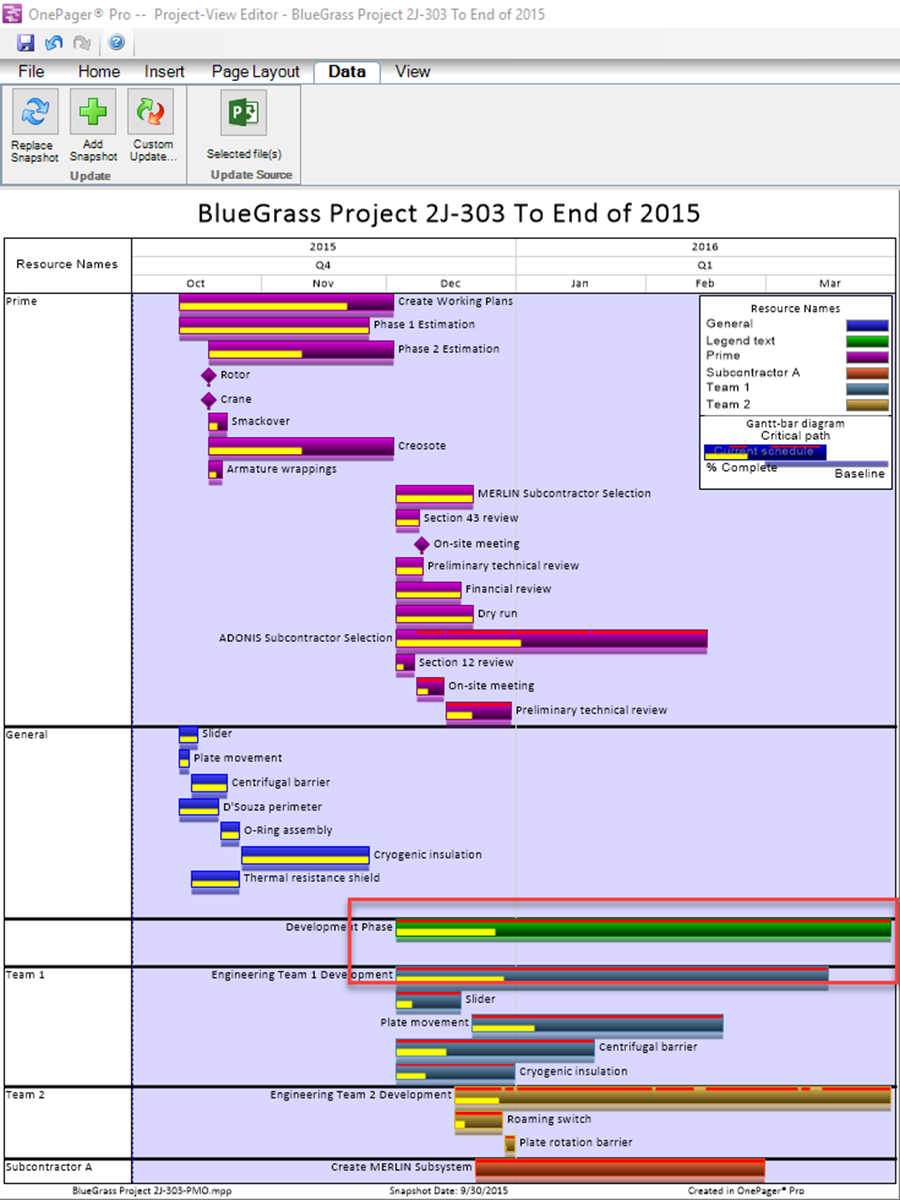 Organization of Articles In the Conditional Import SectionThere are four detailed articles in this section available at the links below corresponding to each of the desktop products offered by Chronicle Graphics, Inc: OnePager Pro Add-in, OnePager Pro Desktop, OnePager Express Add-in, and OnePager Express Desktop. Within each article, there is an Overview sub-section and the articles are further sub-sectioned by the three options that are available to you from the OnePager choices form: NEW, UPDATE, and OPEN.
Related Links:Conditional Formatting (Portal) Using the OnePager "Data" Tab's "Selected file(s)" Button OnePager Express Import of Data from Microsoft Excel Message to Assist with Setting Import Flags When No Data Are Imported Understanding Project Views and Snapshots for OnePager Pro Understanding Project Views and Snapshots for OnePager Express (7.18.1-60) |